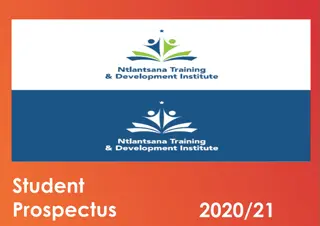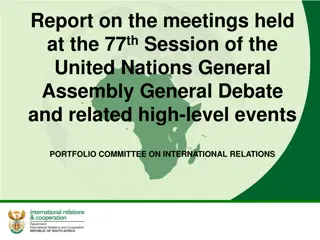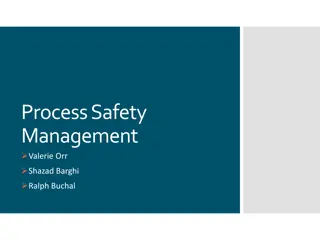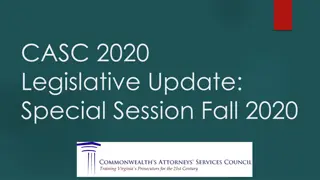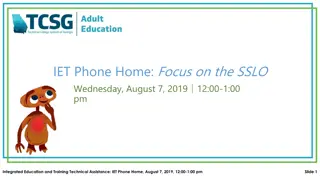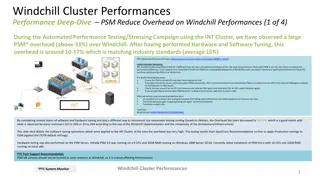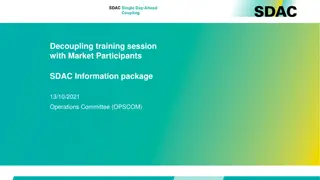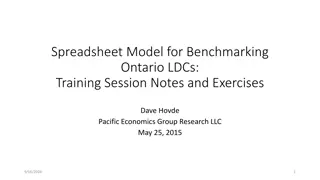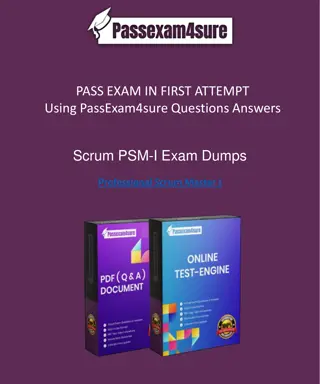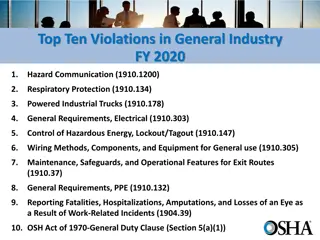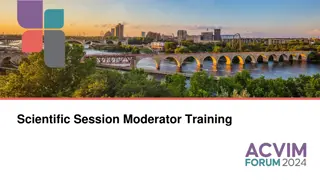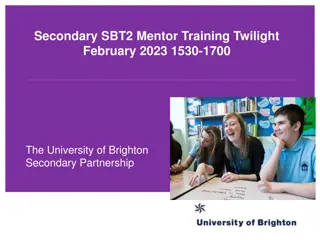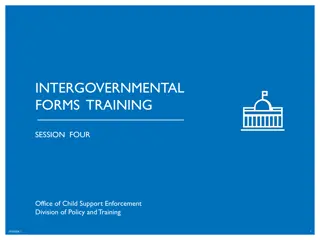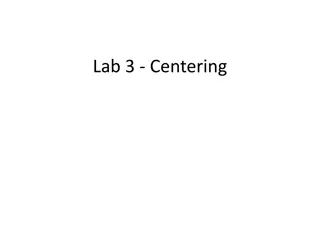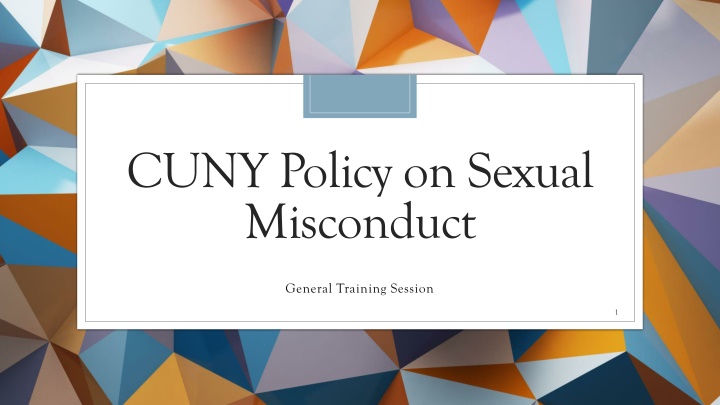
CUNY Policy on Sexual Misconduct Training
Learn about CUNY's Policy on Sexual Misconduct, including prohibited behaviors, available resources, investigation procedures, and key legal frameworks. Explore the goals and training topics related to Title IX compliance and stakeholder responsibilities.
Download Presentation

Please find below an Image/Link to download the presentation.
The content on the website is provided AS IS for your information and personal use only. It may not be sold, licensed, or shared on other websites without obtaining consent from the author. If you encounter any issues during the download, it is possible that the publisher has removed the file from their server.
You are allowed to download the files provided on this website for personal or commercial use, subject to the condition that they are used lawfully. All files are the property of their respective owners.
The content on the website is provided AS IS for your information and personal use only. It may not be sold, licensed, or shared on other websites without obtaining consent from the author.
E N D
Presentation Transcript
CUNY Policy on Sexual Misconduct General Training Session 1
INTRODUCTION TO THE POLICY 2
CUNY Policy on Sexual Misconduct ( The Policy ) Defines prohibited Sexual Misconduct Outlines resources available to those affected by Sexual Misconduct Details CUNY s procedures for investigating and adjudicating allegations of Sexual Misconduct 3
The Policy also: Prohibits Retaliation and Knowingly Submitting False Information and Evidence Identifies Confidential and Responsible Employees Addresses/prohibits certain Intimate Relationships Identifies the role of the Title IX Coordinator Discusses CUNY/Campus specific Training Obligations 4
The Policy is based on federal, state and local laws: Federal law Title IX State law New York Education Law Article 129-B ( Enough is Enough ) Local law New York City Human Rights Law Every time there is a change in the law, CUNY must review and revise this Policy. UPDATE: May 2020 the United States Department of Education issued revised regulations to Title IX, which necessitated a major revision to the Policy 5
GOALS FOR THIS TRAINING 6
Discuss the new regulations issued by the USDOE in May 2020 Review major changes to the Policy as a result of implementation of the new regulations on August 14, 2020 Address the following, required training topics: The definition of Title IX Sexual Harassment How to conduct an investigation and grievance process in compliance with the revised Policy and Title IX regulations Some specific topics we will address: The scope of CUNY s education program or activity How to serve impartially Issues of relevance This training is designed to: 7
This training is designed to train the following PSM Stakeholders: Title IX Coordinators and Title IX Investigators Members of the CUNY-wide Sexual Misconduct Panel (who will serve as decisionmakers on the Adjudication and Appeals Committees) Informal Resolution Facilitators CUNY-appointed cross examination advisors Presenters Student Conduct Officers Designated Campus Presenters 8
In addition to this general training session, CUNY provided the following, specialized and role specific trainings: Title IX Coordinators and Investigators CUNY-wide Sexual Misconduct Panel Including Chairpersons Presenters Training CUNY-appointed cross examination advisors Informal Resolution (designed for facilitators and Title IX Coordinators) 9
May 2020 Title IX Regulations Overview Title IX of the Education Amendments of 1972 ( Title IX ), 20 U.S.C. 1681-1688 is the federal law that prohibits sex discrimination in education. A USDOE Press release on May 6, 2020 described the regulations as historic action to strengthen Title IX protections for survivors of sexual misconduct and to restore due process in campus proceedings to ensure all students can pursue an education free from sex discrimination. The regulations became effective on August 14, 2020. 10
May-June 2020 Committee comprised of 3 Office of General Counsel ( OGC ) attorneys and 3 campus attorneys revised the Policy to comply with the new regulations July 14, 2020 OGC and the Office of Risk, Audit and Compliance ( RAC ) shared a draft of the revised Policy to dozens of CUNY stakeholders, including: The Chancellor s cabinet College Presidents/Deans Secretary to the BOT Vice Presidents for Student Affairs Legal Affairs Designees Title IX Coordinators Faculty and Student Leaders CUNY s revised Policy on Sexual Misconduct 11
OGC considered all comments submitted and many comments and suggestions were incorporated OGC and RAC also worked with various CUNY stakeholders, including campus Title IX Coordinators, to prepare for implementation of the revised Policy. This included the following projects: Revising the Investigation Manual used by Title IX Coordinators and investigators Drafting various templates to provide uniformity and support to Title IX Coordinators Revising the CUNY Sexual Misconduct Allegation Form Preparing an Implementation Memo to assist campus level implementation of the Policy August 12, 2020 The Board of Trustees adopted the revised Policy August 14, 2020 The Policy went into effect. CUNY s revised Policy on Sexual Misconduct (cont). 12
Summary of Major Changes to PSM, necessitated by the regulations Definition of Title IX Sexual Harassment Two sets of procedures Title IX Sexual Harassment Non-Title IX Sexual Misconduct Title IX Grievance Process 13
The USDOE defines Title IX Sexual Harassment as Conduct on the basis of sex that occurs in CUNY s education program or activity against a person in the United States and that satisfies one or more of the following: (1) a CUNY employee conditioning the provision of an aid, benefit, or service of CUNY on an individual s participation in unwelcome sexual conduct; (2) unwelcome conduct determined by a reasonable person to be so severe, pervasive, and objectively offensive that it effectively denies a person equal access to CUNY s education program or activity; or (3) Sexual Assault, Dating Violence, 14 Domestic Violence, or Stalking as defined in this Policy.
Title IX Sexual Harassment Conduct on the basis of sex that occurs in CUNY s education program or activity against a person in the United States and that satisfies one or more of the following: On the basis of sex (1) a CUNY employee conditioning the provision of an aid, benefit, or service of CUNY on an oThe Regulations don t specify what this means individual s participation in unwelcome sexual conduct; oCUNY s policy interprets based on sex to include sexual orientation, gender, gender expression and (2) unwelcome conduct determined by a reasonable gender identity, including transgender status. person to be so severe, pervasive, and objectively offensive that it effectively denies a person equal access to CUNY s education program or activity; or (3) Sexual Assault, Dating Violence, Domestic Violence, or Stalking as defined in this Policy. 15
Title IX Sexual Harassment Conduct on the basis of sex that occurs in CUNY s education program or activity against a person in the United States and that satisfies one or more of the that occurs in CUNY s education program or activity... following: (1) a CUNY employee conditioning the provision of an aid, Education Program or Activity is defined in the regulations to includes locations, events, or circumstances over which the recipient exercised substantial control over both the respondent and the context in which the sexual harassment occurs, and also includes any building owned or controlled by a student organization that is officially recognized by a postsecondary institution. 106.44(a) benefit, or service of CUNY on an individual s participation in unwelcome sexual conduct; (2) unwelcome conduct determined by a reasonable person to be so severe, pervasive, and objectively offensive that it effectively denies a person equal access to CUNY s education program or activity; or (3) Sexual Assault, Dating Violence, Domestic Violence, or Stalking as defined in this Policy. 16
that occurs in CUNYs education program or activity... Off campus activity does not necessarily mean the behavior is outside CUNY s education program or activity Off campus that likely is within CUNY s education program or activity: CUNY sponsored trips or CUNY-related travel CUNY sponsored events held off campus Off campus review session organized by a TA Off campus that likely is not within CUNY s education program or activity: Off campus review session organized by students Off campus social gatherings among students Off campus domestic/dating violence 17
Key questions (If the answer is yes to any of these questions, consider the off-campus behavior as part of CUNY s education program or activity) (1) Did the off-campus incident occur as part of CUNY s operations ? (2) Did CUNY exercise substantial control over the respondent and the context in which the incident occurred? Did CUNY fund, promote or sponsor the event or circumstance where the incident occurred? (3) Did the incident occur at an off-campus building owned or controlled by a student organization officially recognized by CUNY? that occurs in CUNY s education program or activity... 18
What about electronic behavior? Yes. [P]rogram or activity encompass all of That occurs in CUNY s education program or activity... the operations of such recipients, and such operations may certainly include computer and internet networks, digital platforms, and computer hardware or software owned or operated by, or used in the operations of, the recipient. 19
Title IX Sexual Harassment Conduct on the basis of sex that occurs in CUNY s education program or activity against a person in the United Against a person in the United States States and that satisfies one or more of the following: (1) a CUNY employee conditioning the provision of an aid, benefit, or service of CUNY on an individual s participation in unwelcome sexual conduct; (2) unwelcome conduct determined by a reasonable person to be so severe, pervasive, and objectively offensive that it effectively denies a person equal access to CUNY s education program or activity; or (3) Sexual Assault, Dating Violence, Domestic Violence, or Stalking as defined in this Policy. 20
Title IX Sexual Harassment Conduct on the basis of sex that occurs in CUNY s education program or activity against a person in the United States and that satisfies one or more of the following: (1) a CUNY employee conditioning the provision of an aid, benefit, or service of CUNY on an individual s participation in unwelcome sexual conduct; Quid Pro Quo Something for something (2) unwelcome conduct determined by a reasonable person to be so severe, pervasive, and objectively offensive that it effectively denies a person equal access to CUNY s education program or activity; or (3) Sexual Assault, Dating Violence, Domestic Violence, or Stalking as defined in this Policy. 21
Title IX Sexual Harassment Conduct on the basis of sex that occurs in CUNY s education program or activity against a person in the United States and that satisfies one or more of the following: Hostile Environment (1) a CUNY employee conditioning the provision of an aid, Severe, Pervasive andObjectively Offensive Must meet all three benefit, or service of CUNY on an individual s participation in unwelcome sexual conduct; Denies a person equal access to CUNY s education program or activity Denied Equal access, not total access (2) unwelcome conduct determined by a reasonable person to be so severe, pervasive, and objectively offensive that it effectively denies a person equal access to CUNY s education program or activity; or (3) Sexual Assault, Dating Violence, Domestic Violence, or Stalking as defined in this Policy. 22
Title IX Sexual Harassment Conduct on the basis of sex that occurs in CUNY s education program or activity against a person in the United States and that satisfies one or more of the following: Regulations require Clery/VAWA definitions (1) a CUNY employee conditioning the provision of an aid, CUNY s Policy cites to CUNY s definitions, which benefit, or service of CUNY on an individual s participation in unwelcome sexual conduct; encompass the Clery/VAWA definitions To note - First and Third prongs do not need to satisfy the (2) unwelcome conduct determined by a reasonable person to be so severe, pervasive, and objectively offensive that it severe, pervasive and objectively offensive standard effectively denies a person equal access to CUNY s education program or activity; or (3) Sexual Assault, Dating Violence, Domestic Violence, or Stalking as defined in this Policy. 23
WHAT ABOUT... Sex based harassment that does not meet the severe, pervasive and objectively offensive standard? A sexual assault between students that occurs at a private residence? Sexual Misconduct with a reasonable connection to CUNY, that occurs outside the United 24 States?
Summary of Major Changes to PSM, necessitated by the regulations Definition of Title IX Sexual Harassment Two sets of procedures Title IX Sexual Harassment Non-Title IX Sexual Misconduct Title IX Grievance Process 25
CUNYs Two Procedure Structure: Why two sets of procedures? The strict and complex Title IX Grievance Procedure for Title IX Sexual Harassment matters are not required when Sexual Misconduct falls outside the scope of Title IX Sexual Harassment CUNY determined that it would not use the Title IX Grievance Procedure for Non-Title IX Sexual Misconduct matters Title IX Sexual Harassment & Non-Title IX Sexual Misconduct 26
Title IX Sexual Harassment Matters If conduct meets the USDOE definition of Title IX Sexual Harassment must follow Title IX Grievance Procedure Parties are entitled to the Title IX Grievance Procedure if the alleged conduct meets the Title IX Sexual Harassment definition 27
Non-Title IX Sexual Misconduct Matters Prohibited Sexual Misconduct that does not meet the USDOE definition of Title IX Sexual Harassment A different process which largely mirrors the CUNY investigation and adjudication process that existed under previous versions of the Policy, with a few changes and updates. 28
Similarities Both Title IX Sexual Harassment & Non-Title IX Sexual Misconduct matters.... Right to an investigative process that is fair, impartial, timely, thorough and provides a meaningful opportunity to be heard Burden of proof and burden of gathering evidence rests on the college (preponderance of the evidence) The opportunity to offer evidence; have irrelevant evidence excluded from a hearing Parties have access to the same supportive measures and accommodations Can be resolved through Informal Resolution (except for allegations that an employee sexually harassed a student) Parties have the right to be accompanied by an advisor of their choice throughout the process Investigations 120-day time frame Hearings and Appeals will be heard by members of the CUNY-wide Sexual Misconduct Panel Appeal grounds - (1) procedural irregularity that affected outcome; (2) new evidence not reasonably available at time of hearing that could affect outcome; (3) conflict of interest that affected outcome; or (4) disproportionate nature of penalty. 29
Differences Title IX Sexual Harassment Matters Title IX Formal Complaint required to initiate the grievance process Must be signed by the complainant or Title IX Coordinator Cannot be filed anonymously Complainant must be participating in or attempting to participate in CUNY s education program or activity at the time the Title IX Formal Complaint is filed Subject to mandatory or discretionary dismissal from the Title IX Grievance Process; with the right to appeal any dismissal 30
Differences Title IX Sexual Harassment Matters Investigation Prior to completion of the investigative report, the right to review all relevant documents and materials gathered during the investigation and the right to respond in writing. After completion of the investigative report, the right to review the report and the right to respond in writing. Investigative reports will only summarize evidence and will not include recommendations regarding responsibility 31
Differences Title IX Sexual Harassment Matters (cont). Hearing: The right to a hearing (both employee and student respondents) Decision-maker (adjudication committee) will review investigative report and parties written responses prior to hearing CUNY-appointed cross examination advisor must be provided if a party does not have an advisor at a hearing If a witness does not make themselves available for cross examination (either by their absence or refusal to answer questions) the decision maker is strictly prohibited from considering that witness s statements (either at the hearing or in the investigative report) when determining responsibility (Yes, really) Decisions - Written Determination of Responsibility - must contain specific requirements outlined by the Regs 32
Differences Title IX Sexual Harassment Matters (cont). When a respondent is found responsible Remedies for Complainants - Title IX Coordinator must implement remedies for the complainant, designed to restore or preserve equal access to the recipient s education program or activity These may be a continuation of supportive measures and accommodations implemented on an interim basis after an investigation was initiated Because the Respondent has been found responsible the remedies can be disciplinary, punitive and/or may burden respondent (whereas interim measures prior to a finding of responsibility may not) 33
Differences Title IX Sexual Harassment Matters (cont). Sanctions for Respondent Students Warning Suspension Expulsion Employees - CBA employees - Sanction = referral for discipline under applicable CBA Non CBA employees Reprimand suspension - termination 34
Differences Non-Title IX Sexual Misconduct Matters May proceed anonymously, although this seriously restricts investigation and/or potential corrective action Jurisdiction CUNY education program or activity restriction does not apply ON CUNY property OFF CUNY property that has a reasonable connection to CUNY Investigation Investigative reports will summarize evidence and will include recommendations regarding responsibility If Complainant is a student, report must be provided to both parties If the allegations are unsubstantiated student complainant has the right to appeal the finding to an Appeal Committee Changed to comply with EIE right to appeal a determination to an appeal panel Following appeal, if any, report provided to the President for appropriate action Student respondents referral for disciplinary hearing Employee respondents referral for discipline under applicable CBA 35
Differences Non-Title IX Sexual Misconduct Matters (cont). Hearing Only student respondents will proceed to hearing Only substantiated cases will proceed to hearing Prior to hearing, parties have the right to review evidence college intends to use at hearing 36
Summary of Major Changes to PSM, necessitated by the regulations Definition of Title IX Sexual Harassment Two sets of procedures Title IX Sexual Harassment Non-Title IX Sexual Misconduct Title IX Grievance Process 37
Title IX Grievance Process - From Start to Finish 38
Title IX Formal Complaint Initiates the Title IX Grievance Process Required before the grievance process can proceed Receipt requires that CUNY follow the Title IX Grievance Process What is a Title IX Formal Complaint? In short: A document alleging Title IX Sexual Harassment against a respondent. But, it s not that simple - Form and Substance requirements: 39
Title IX Formal Complaint Form Filed by a complainant (or a Title IX Coordinator those circumstances to be addressed in that breakout session) Physical document, email or electronic submission Complainant s physical or digital signature or otherwise indicates that the complainant is the person filing the complaint CUNY Sexual Misconduct Allegation Form A tool, not a requirement CUNY is prohibited from requiring that a complainant utilize a specific institutional form for this purpose 40
Title IX Formal Complaint (cont). Substance Must allege behavior, which if true, meets the definition of Title IX Sexual Harassment There is no requirement of a detailed statement of facts in the Regulations But to meet the severe, pervasive and objectively offensive standard - some level of detail would be required to ensure the allegations met the definition of Title IX Sexual Harassment Requesting that CUNY investigate the allegations Is there a statute of limitations? No, but the requirement that a complainant be participating in or attempting to participate in CUNY s education program or activity at the time of filing the Title IX Formal Complaint operates as a de facto statute of limitations 41
Initiation of Title IX Grievance Procedure Notification to known parties that the college is commencing a Title IX Grievance Procedure Written Notice 42
Dismissal of a Title IX Formal Complaint Mandatory Dismissals If, at any time after receipt of the Title IX Formal Complaint, it becomes clear that the allegations, if true, do not meet the definition of Title IX Sexual Harassment Must dismiss 43
Dismissal of a Title IX Formal Complaint Discretionary Dismissals May dismiss The complainant notifies the Title IX Coordinator in writing that the complainant would like to withdraw the Title IX Formal Complaint or any allegations therein; The respondent is no longer enrolled or employed by CUNY; or Specific circumstances exist that prevent the college from gathering evidence sufficient to reach a determination as to the Title IX Formal Complaint or allegations therein. 44
Process following dismissal Written dismissal notice will include: Basis for dismissal Whether the allegations will proceed as a Non-Title IX Sexual Misconduct Matter The parties right to appeal and procedures for doing so Appeals decided by University Title IX Director Appeals will be sent to University Title IX Director (Appeals-TitleIX@cuny.edu) A Title IX Coordinator must wait until an appeal under this section is decided by the University Title IX Director before taking any further action as a Non-Title IX Sexual Misconduct matter. 45
Investigation The Title IX Coordinator is responsible for conducting investigations in a prompt, thorough, and impartial manner The college must make reasonable efforts to ensure that the investigation is carried out within a reasonably prompt timeframe. CUNY s Policy 120 days upon receipt of the Title IX Formal Complaint Formal Resolution and Investigation 46
Formal Resolution and Investigation To offer evidence - including both fact and expert witnesses and other inculpatory and exculpatory evidence; Party rights during the investigation 47
To exclusion of medical records, unless the college obtains the party s voluntary, written consent includes the college s access, consideration, disclosure or other use records that are made or maintained by a physician, psychiatrist, psychologist or other recognized professional or paraprofessional Formal Resolution and Investigation Party rights during the investigation 48
To exclude questions and evidence about their own sexual predisposition or prior sexual behavior, Exceptions - (1) to prove that someone other than the respondent committed the conduct alleged by the complainant, or (2) complainant s prior sexual behavior with respect to the respondent and are offered to prove consent (complainant only) Formal Resolution and Investigation Party rights during the investigation 49
Post Investigation Review of Relevant Documents and Materials Parties have the right to: Inspect and review any evidence obtained as part of the investigation that is directly related to the allegations raised in a Title IX Formal Complaint, including inculpatory or exculpatory evidence whether obtained from a party or other source, consistent with FERPA and other law; and To submit a written response within ten (10) days of receiving said evidence and To have that written response considered by the Title IX Coordinator prior to the investigative report being finalized; The parties and their advisors must sign an agreement not to disseminate any of the evidence subject to inspection and review or use such evidence for any purpose unrelated to the Title IX grievance process. 50





